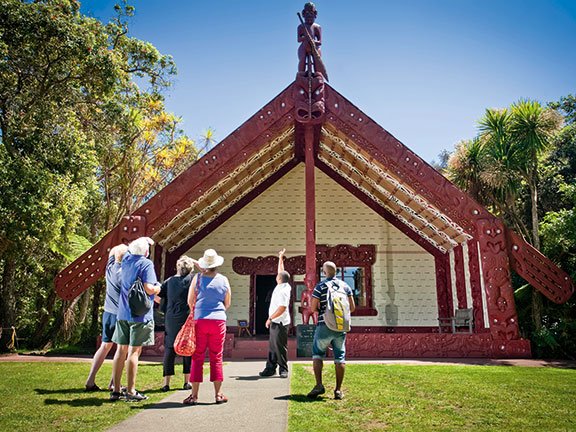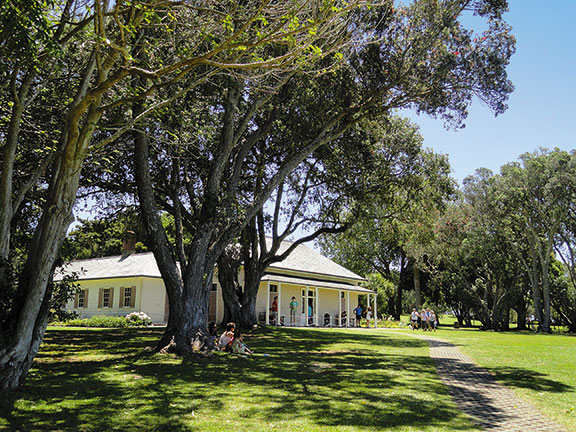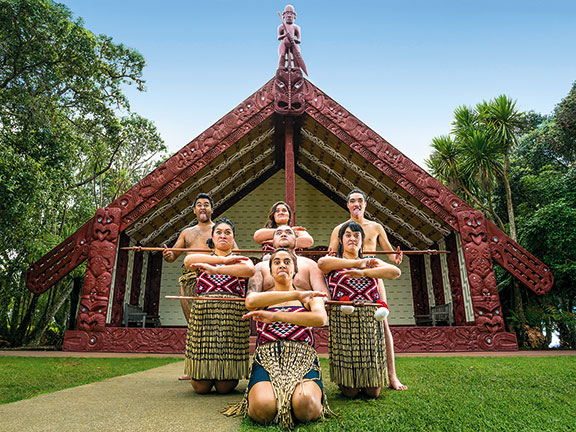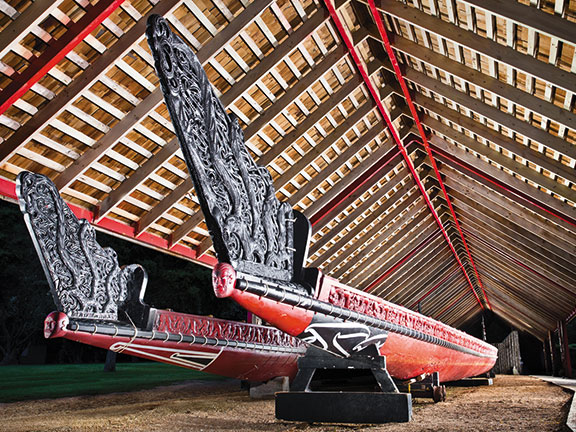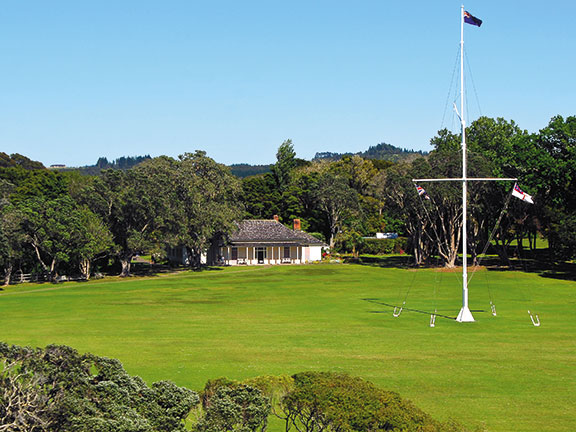You cannot ignore New Zealand's history when you are based in the Bay of Islands. It was certainly a major drawcard for us as we planned a return to the winterless north to coincide with the arrival of the shortest day.
Every fool knows the cold gets stronger when the days grow longer so we should not have been surprised to arrive there during one of the worst wide-spread storms New Zealand has faced. As an intense low pressure system threatened to cover the entire country, the co-pilot expressed concerns that flights out of Christchurch would be grounded.
Nor did it look good from where I was sitting on Waiheke, where wild winds would likely disrupt ferry crossings. Luckily weather forecasting is not an exact science. We scraped in on both counts and by 9.30am on day one, we were hitting the highway heading north. Yes!
We based ourselves in Russell. Ensconced there in our cosy eyrie high above the wharf, we happily watched the water traffic and weather systems while we planned our days. The Treaty Grounds at Waitangi were right across the bay, as dominant in our daily view as they had been in our minds since the idea of a return trip was first mooted months earlier during a whistle-stop tour. It was, in fact, the only thing firmly on our agenda.
We agreed this holiday was all about chilling. Clearly the universe heeded our hopes, because chill we did. With a polar blast of this intensity, even the winterless north could not escape entirely unscathed — although it was clear from news bulletins there was not a better place in the country to ride out the super-storm.
Under any conditions, the Bay of Islands is the domestic destination for winter if you're looking for (comparative) warmth, temperature-wise. However, you are assured of a warm welcome from the locals, no matter what time of the year you go there.
Tourism is tops in the north and nowhere is this more apparent than at the Waitangi Treaty Grounds, which each year attracts more around 150,000 visitors keen to learn about Aotearoa's most important historic place. I'll bet my bottom dollar you'll be blown away by the experience. We certainly were.
The co-pilot is a typical southern man. He favours one-word responses like, 'good', 'yep', 'no', and 'OK'. So when he waxed lyrical about our Waitangi tour, I thought it was worth recording. Here's what he had to say: "Our tour of Waitangi Treaty Grounds was informative and factual, but also an honest and powerful account of the history of our combined nation beginning in the 1800s. The team at Waitangi offers a welcoming invitation to all New Zealanders and visitors alike to feel free to share this very historic place forever into the future."
Crikey — that was a year's worth of words.
For me, the personal greeting extended to every visitor to Waitangi is one which sets it apart. Entry is by donation. As we chatted with staff about what we hoped to achieve from our visit, they encouraged us to join a tour. We're not naturally joiners, although we were soon to find this is an experience not to be missed.
From the outset our guide Lyall delivered history with humour and we found ourselves laughing all the way around Waitangi as we learnt some startling facts about the birth of our nation. I did not previously know that New Zealand is the only nation in the world legally allowed to fly two ensigns from its merchant ships. The United Tribes of New Zealand ensign was in use from 1834, six years before the signing of the treaty in 1840.
The white ensign still flies proudly on the Waitangi flagstaff alongside the New Zealand flag and the Union Jack.
We also learned more about the motivations of Hone Wiremu Heke Pokai — a high-ranking Ngapuhi rangitira (chief), Anglican lay preacher, and former signatory to the the Treaty of Waitangi in 1840 — now better known for cutting down the flagstaff at Russell four times.
On another day we visited Flagstaff Hill and, with renewed respect for Heke's plight, I reflected quietly on the perceived breaches of the recently-signed treaty which led to his protest. Afterwards we walked up to the impressive sundial monument opposite and as we descended again to the car park, a gale sprung up from nowhere and the flagpole began wailing into the wind. It was spine chilling.
The Waitangi National Trust estate was purchased by Lord and Lady Bledisloe in 1932. The couple recognised the importance of the 1000-acre site and subsequently gifted to the nation. The establishing trust oversaw the restoration of Treaty House, the building of the Whare Rununga, and the launch of Ngatokimatawhaorua, the world's largest waka taua (war canoe) for the centennial in 1940. The Bledisloes' enduring gift is a must-see for New Zealanders wanting to gain a better understanding of their heritage.
Our desire for an even greater understanding led to several more excursions to historic places. Mission House was closed for renovations, however we wandered for a while in the churchyard, reading the inscriptions on tombstones and were struck by the number of soldiers in the New Zealand Wars who had died from friendly fire. Some friends those luckless soldiers had.
Another great graveyard (if you'll forgive the obvious oxymoron) is Christ Church in Russell, where Lieutenant Hobson read his proclamation a week before the signing of the Treaty. Later, during a trip to Kerikeri, a spontaneous decision to investigate Rewa's Village rewarded us with a brilliant insight into early Maori life.
Russell Museum also makes up with interest what it lacks in size. The museum is open every day, with the exception of Christmas Day. Allow at least an hour to immerse yourself in the displays of Maori and early European settler artifacts and settle into an armchair in the alcove to watch a grainy film about the settlement of the region.
Russell, known previously as Kororareka (sweet penguin) was an established settlement of Ngare Raumati when Captain Cook sailed the Endeavour into the Bay of islands in 1769. His visit is remembered at the museum with the 1:5 scale model of the Endeavour.
Cook was followed by other explorers, including Marc-Joseph Marion du Fresne in 1772.
The French, who communicated with Maori in the threads of a common language (Tahitian), initially enjoyed good relations with local Maori. However, du Fresne was committed to colonisation of the country, and Maori became suspicious of the arsenal of weapons they encountered by chance while relations remained friendly.
In the months following, small skirmishes led to full scale battles involving up to 1500 Maori warriors. During an attack on a defended pa the lives of more than 250 Maori, five of them chiefs, and 26 French soldiers, were lost.
Departing finally on 12 July, 1772, the French buried a bottle containing the arms of France, together with a declaration of formal possession of the whole country they named France Australe, at Waipoa, their final camp on the island of Moturua. In 1838, French priest Jean Baptiste Pompalier's celebration of mass at Hokianga was to renew fears of French colonisation among the British and spur them to formally stake their claim.
Following on from du Fresne were whalers, sealers, Kauri spar and flax merchants, deserting sailors and convicts escaped from Australia. A couple early residents of the region were escaped convicts Charlotte Badger and Catherine Hagarty, who lived there around 1806. With their cohorts, the pair had seized a vessel off the coast of Tasmania, hell-bent on heading for Russell, which was by this time known as The Hellhole of the Pacific — a place where vigilante crews roamed the lawless streets. Reporting to a select committee of the House of Lords in 1838, one John Flatt told the peers of the realm there were so many runaway seamen and drunkards in the region that local Maori referred to the English as "a nation of drunkards".
The pursuit of law and order was eventually to become another springboard for the creation of New Zealand's first capital, Okiato. The scant remains of the capital consist of a deep well on a waterfront reserve near the ferry crossing to Opua. Such transience is a sobering lesson to us all and further underscores the generosity of the Bledisloes' Waitangi gift.
As fascinating as the region's human history is, we were also captivated by unexpected glimpses of the natural world. A weka scurrying across the road near Flagstaff Hill made me gasp with delight. Later we observed a cheeky bird at even closer range near our accommodation, and a ferry trip to Paihia delivered the unexpected bonus of a small pod of dolphins fishing near our vessel.
The physical beauty of the region cannot be underestimated. Wherever you go, jaw dropping views abound. We returned to Auckland via the spectacular coastal route, providing some consolation for the holiday's end — and of course, as is usual on these occasions, provided us with even more reasons to return.
For the latest reviews, subscribe to our Motorhomes, Caravans & Destinations magazine here.

The road to Milford Sound
Explore the awe-inspiring journey to Milford Sound through Fiordland National Park – from scenic DOC campsites and iconic hikes to wildlife cruises and luxury stays

